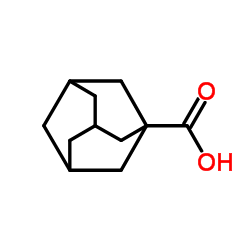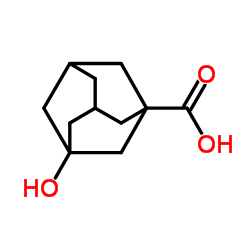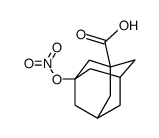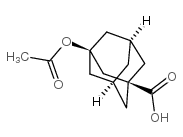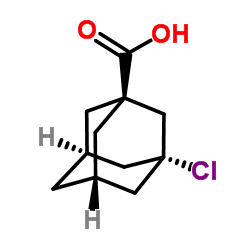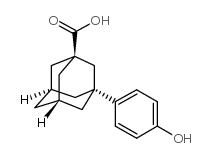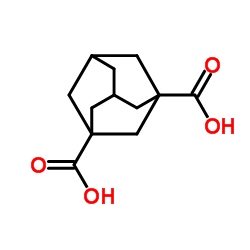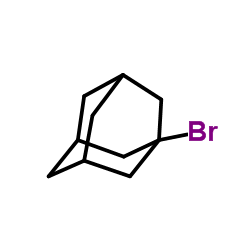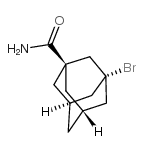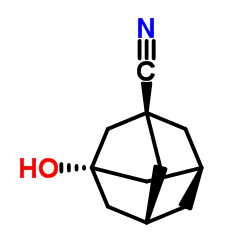21816-08-0
| Name | 3-Bromoadamantane-1-carboxylic acid |
|---|---|
| Synonyms |
tricyclo[3.3.1.1~3,7~]decane-1-carboxylic acid,3-bromo
Tricyclo[3.3.1.1]decane-1-carboxylic acid, 3-bromo- 3-Bromadamantan-1-carbonsaeure Tricyclo[3.3.1.1]decane-1-carboxylic acid, 3-bromo-, (5R,7S)- 3-Bromoadamantane-1-carboxylic acid 3-Bromoadamantane-1-carboxylicacid 1-bromo-3-adamantanecarboxylicacid MFCD00167820 1-bromo-3-adamantanecarboxylicaci acide bromo-3 adamantylcarboxylique (1r,3s,5R,7S)-3-Bromo-1-adamantanecarboxylic acid 3-bromo-1-carboxyadamantane 3-bromoadamantan-1-carboxylic acid 3-Bromadamantancarbonsaeure 3-Bromo-1-Amantane Carboxylic Acid 3-Bromo-1-adamantanecarboxylic acid 3-Bromo-adamantane-1-carboxylic acid IFLAB-BB F0035-0448 3-Bromo-1-Adamantane Carboxylic Acid 3-Bromo-1-adamantane-carboxylic acid 1-Bromo-3-Adamantane Carboxylic Acid 3-bromo-adamantane-1-carboxylicacid |
| Density | 1.7±0.1 g/cm3 |
|---|---|
| Boiling Point | 354.2±25.0 °C at 760 mmHg |
| Melting Point | 147-148ºC |
| Molecular Formula | C11H15BrO2 |
| Molecular Weight | 259.140 |
| Flash Point | 168.0±23.2 °C |
| Exact Mass | 258.025543 |
| PSA | 37.30000 |
| LogP | 2.61 |
| Vapour Pressure | 0.0±1.7 mmHg at 25°C |
| Index of Refraction | 1.638 |
| Storage condition | 2-8°C |
Synonym: Section 2 - COMPOSITION, INFORMATION ON INGREDIENTS
Risk Phrases: 36/37/38 Section 3 - HAZARDS IDENTIFICATION EMERGENCY OVERVIEW
Irritating to eyes, respiratory system and skin. Potential Health Effects Eye: Causes eye irritation. Skin: Causes skin irritation. May be harmful if absorbed through the skin. Ingestion: May cause irritation of the digestive tract. May be harmful if swallowed. Inhalation: Causes respiratory tract irritation. May be harmful if inhaled. Chronic: Not available. Section 4 - FIRST AID MEASURES Eyes: Flush eyes with plenty of water for at least 15 minutes, occasionally lifting the upper and lower eyelids. Get medical aid. Skin: Get medical aid. Flush skin with plenty of water for at least 15 minutes while removing contaminated clothing and shoes. Ingestion: Get medical aid. Wash mouth out with water. Inhalation: Remove from exposure and move to fresh air immediately. If not breathing, give artificial respiration. If breathing is difficult, give oxygen. Get medical aid. Notes to Physician: Treat symptomatically and supportively. Section 5 - FIRE FIGHTING MEASURES General Information: As in any fire, wear a self-contained breathing apparatus in pressure-demand, MSHA/NIOSH (approved or equivalent), and full protective gear. Extinguishing Media: Use water spray, dry chemical, carbon dioxide, or chemical foam. Section 6 - ACCIDENTAL RELEASE MEASURES General Information: Use proper personal protective equipment as indicated in Section 8. Spills/Leaks: Vacuum or sweep up material and place into a suitable disposal container. Section 7 - HANDLING and STORAGE Handling: Avoid breathing dust, vapor, mist, or gas. Avoid contact with skin and eyes. Storage: Store in a cool, dry place. Store in a tightly closed container. Section 8 - EXPOSURE CONTROLS, PERSONAL PROTECTION Engineering Controls: Facilities storing or utilizing this material should be equipped with an eyewash facility and a safety shower. Use adequate ventilation to keep airborne concentrations low. Exposure Limits CAS# 21816-08-0: Personal Protective Equipment Eyes: Not available. Skin: Wear appropriate protective gloves to prevent skin exposure. Clothing: Wear appropriate protective clothing to prevent skin exposure. Respirators: Follow the OSHA respirator regulations found in 29 CFR 1910.134 or European Standard EN 149. Use a NIOSH/MSHA or European Standard EN 149 approved respirator if exposure limits are exceeded or if irritation or other symptoms are experienced. Section 9 - PHYSICAL AND CHEMICAL PROPERTIES Physical State: Solid Color: white Odor: Not available. pH: Not available. Vapor Pressure: Not available. Viscosity: Not available. Boiling Point: Not available. Freezing/Melting Point: 143 - 145 deg C Autoignition Temperature: Not available. Flash Point: Not available. Explosion Limits, lower: Not available. Explosion Limits, upper: Not available. Decomposition Temperature: Solubility in water: Specific Gravity/Density: Molecular Formula: C11H15BrO2 Molecular Weight: 259 Section 10 - STABILITY AND REACTIVITY Chemical Stability: Not available. Conditions to Avoid: Incompatible materials. Incompatibilities with Other Materials: Oxidizing agents. Hazardous Decomposition Products: Carbon monoxide, carbon dioxide, hydrogen bromide, acrid smoke and fumes, bromine. Hazardous Polymerization: Has not been reported Section 11 - TOXICOLOGICAL INFORMATION RTECS#: CAS# 21816-08-0: AU4452500 LD50/LC50: Not available. Carcinogenicity: 3-Bromoadamantane-1-carboxylic acid - Not listed by ACGIH, IARC, or NTP. Other: See actual entry in RTECS for complete information. Section 12 - ECOLOGICAL INFORMATION Section 13 - DISPOSAL CONSIDERATIONS Dispose of in a manner consistent with federal, state, and local regulations. Section 14 - TRANSPORT INFORMATION IATA No information available. IMO No information available. RID/ADR No information available. Section 15 - REGULATORY INFORMATION European/International Regulations European Labeling in Accordance with EC Directives Hazard Symbols: XI Risk Phrases: R 36/37/38 Irritating to eyes, respiratory system and skin. Safety Phrases: S 26 In case of contact with eyes, rinse immediately with plenty of water and seek medical advice. S 37/39 Wear suitable gloves and eye/face protection. WGK (Water Danger/Protection) CAS# 21816-08-0: No information available. Canada None of the chemicals in this product are listed on the DSL/NDSL list. CAS# 21816-08-0 is not listed on Canada's Ingredient Disclosure List. US FEDERAL TSCA CAS# 21816-08-0 is not listed on the TSCA inventory. It is for research and development use only. SECTION 16 - ADDITIONAL INFORMATION N/A |
CHEMICAL IDENTIFICATION
HEALTH HAZARD DATAACUTE TOXICITY DATA
|
| Symbol |

GHS07 |
|---|---|
| Signal Word | Warning |
| Hazard Statements | H315-H319-H335 |
| Precautionary Statements | P261-P305 + P351 + P338 |
| Personal Protective Equipment | dust mask type N95 (US);Eyeshields;Gloves |
| Hazard Codes | Xi:Irritant; |
| Risk Phrases | R36/37/38 |
| Safety Phrases | S26-S37/39 |
| RIDADR | NONH for all modes of transport |
| RTECS | AU4452500 |
| HS Code | 2916209090 |
|
~95% 
21816-08-0 |
| Literature: Baklan, V. F.; Khil'chevskii, A. N.; Sologub, L. S.; Kukhar, V. P. Journal of Organic Chemistry USSR (English Translation), 1992 , vol. 28, # 10 p. 1680 - 1683 Zhurnal Organicheskoi Khimii, 1992 , vol. 28, # 10 p. 2098 - 2102 |
|
~99% 
21816-08-0 |
| Literature: Harman, David G.; Blanksby, Stephen J. Organic and Biomolecular Chemistry, 2007 , vol. 5, # 21 p. 3495 - 3503 |
|
~52% 
21816-08-0 |
| Literature: Yurchenko, R. I.; Peresypkina, L. P.; Miroshnichenko, V. V.; Yurchenko, A. G. Russian Journal of General Chemistry, 1993 , vol. 63, # 7.1 p. 1072 - 1076 Zhurnal Obshchei Khimii, 1993 , vol. 63, # 7 p. 1534 - 1539 |
|
~89% 
21816-08-0 |
| Literature: Baklan, V. F.; Khil'chevskii, A. N.; Sologub, L. S.; Kukhar, V. P. Journal of Organic Chemistry USSR (English Translation), 1992 , vol. 28, # 10 p. 1680 - 1683 Zhurnal Organicheskoi Khimii, 1992 , vol. 28, # 10 p. 2098 - 2102 |
| Precursor 4 | |
|---|---|
| DownStream 10 | |
| HS Code | 2916209090 |
|---|---|
| Summary | 2916209090 other cyclanic, cyclenic or cyclotherpenic monocarboxylic acids, their anhydrides, halides, peroxides, peroxyacids and their derivatives VAT:17.0% Tax rebate rate:9.0% Supervision conditions:AB(certificate of inspection for goods inward,certificate of inspection for goods outward) MFN tariff:6.5% General tariff:30.0% |

